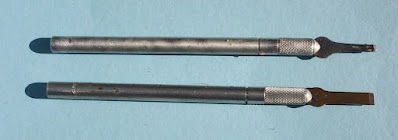In the previous post in this series, I described Southern Pacific’s steel cupola cars, built from 1937 to 1942. For your convenience, here is a link to that post: https://modelingthesp.blogspot.com/2022/02/modeling-sp-cabooses-part-3.html . Now I want to turn to the major change in SP cabooses that occurred immediately after World War II, the change to bay-window caboose designs.
The advent of 10-foot, 6-inch inside-height freight cars, especially automobile cars, was recognized as limiting train visibility from a caboose cupola. SP was aware that other railroads were satisfied with the bay-window design, so in 1947, they purchased 50 cars of this type from American Car & Foundry. Their numbers followed right behind the last steel cupola car, and thus were SP 1235–1269 for Pacific Lines. A new number series was adopted for the 15 T&NO cars, 500–514.
I show below an AC&F builder photo that emphasizes the distinctive characteristics of new Class C-30-4. The roof was smooth, with internal ribs; the end ladders had a new, rectangular top shape; a large lateral running board was provided, slanted to match the roof contour; and the bay window was not only much lower in height than the car side, but had its roof indented below the bay sides. This is the car’s left side, with four windows; the right side had only three windows.
Soon SP was pleased with the new cars, but instead of a re-order at AC&F, returned to the traditional approach, building them at Los Angeles General Shops. In 1949, they built 80 more bay-window cars. The 50 Pacific Lines cars were SP 1270–1319. The T&NO got 30 cars, numbered 515–544, and like Class C-30-4, these cars were owned by SP and leased to T&NO,
These new cars were Class C-30-5 and were virtually identical to Class C-30-4 in most respects, but had a conventional freight-car diagonal-panel roof (external “ribs”). Also, the lateral running board was now level, not slanted. A builder view is shown below (SP photo). Note white safety handrail paint on all these cars.
For a side view in service, here’s a good look at SP 1270 in May of 1949, taken at Eugene by Dick Wolf (Louis Marre collection). This is the right side of the car, with three windows and the tool box.
I should mention that these cars, just like the preceding class, were delivered with vermilion ends. Photos that show the color clearly are rare, but Joe Strapac was able to provide one, taken in the lower yard at Dunsmuir in March 1953.
My own brass model of one of the Class C-30-4 cars is from Precision Scale, distinctive flat roof and all, and I made sure its ends were the right color. This is the right side of the car, with the tool box under the side sill.
The final group of bay-window cars in this group was built in 1951, again at LAGS, called Class C-30-6. They were identical to Class C-30-5 and were numbered SP 1320–1369. SP would purchase no more cabooses until the C-40 classes arrived in 1961 and thereafter. And all future SP cabooses would come from commercial builders. Below is an SP builder photo of the left side of this class.
Model-wise, the numerous C-30-5 and -6 cars are obvious modeling candidates, and they have been done in brass by Challenger (both original and 1980s versions). And they too had vermilion ends. Incidentally, the familiar Athearn HO caboose, with a tall bay window, can’t be used for any of these early classes.
Finally, having mentioned the vermilion ends of these early bay-window cars, I should repeat the orange-ends history for anyone who may not know it. The vermilion ends were introduced in 1947, likely part of an effort to increase visibility of cabooses (aluminum boiler fronts were introduced on steam engines, and “Tiger Stripe” orange paint on diesels, for the same purpose). Evidently, though, vermilion wasn’t regarded as successful.
In March 1954, each SP division was instructed to paint the ends of two cabooses aluminum, so that that color could be tested. By that fall, it was agreed that aluminum was preferable to vermilion for visibility, though both were thought to perform poorly in low light. About at the end of 1954, a further trial was undertaken, this time using Daylight Orange (the color of “Tiger Stripes”), again on two cabooses from each division. By summer 1955, the trial was considered successful, and on October 12, 1955, this color was made standard for the ends of all cabooses, system-wide.
Tony Thompson













































